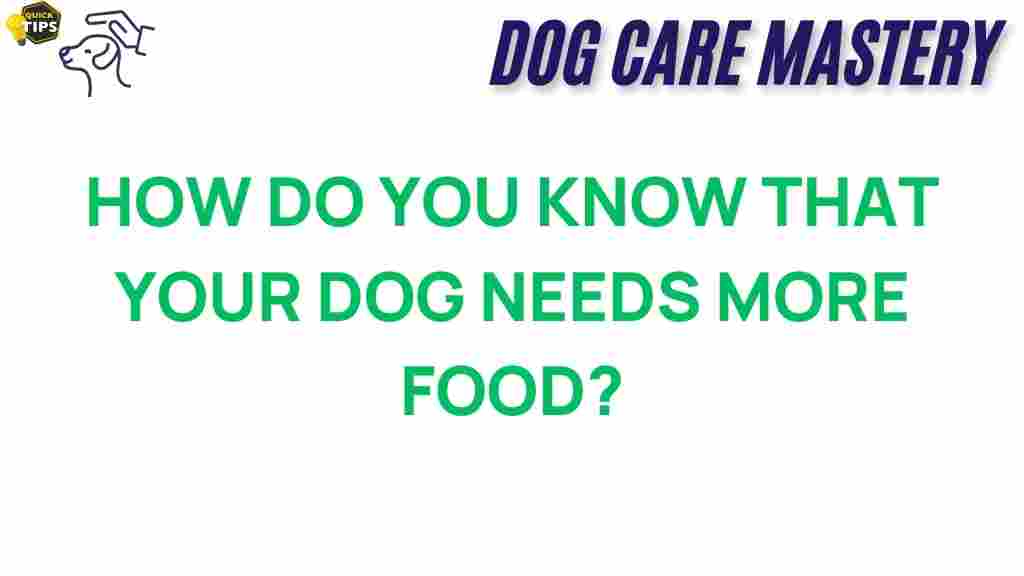Is Your Dog Asking for More Food? Signs You Shouldn’t Ignore
As a responsible dog owner, understanding your dog’s nutritional needs is crucial for their health and well-being. One of the most common concerns among pet parents is whether their dog is asking for more food. While it may seem straightforward, there are various factors to consider, especially when it comes to dog nutrition. In this article, we’ll explore the signs that indicate your dog may need more food, how to assess their dietary requirements, and tips for managing their nutrition effectively.
Understanding Dog Nutrition
Before diving into the signs that your dog might be asking for more food, it’s essential to understand what dog nutrition entails. Proper nutrition is vital for maintaining your dog’s health, energy levels, and overall quality of life. Here are some key components of a balanced diet for dogs:
- Proteins: Essential for growth and muscle development.
- Fats: Provide energy and support cell function.
- Carbohydrates: Offer energy and aid in digestion.
- Vitamins and Minerals: Important for various bodily functions.
Each dog’s dietary needs can vary based on factors such as age, breed, activity level, and health conditions. Therefore, it’s vital to consult with a veterinarian regarding the most suitable diet for your furry friend.
Signs Your Dog May Be Asking for More Food
Now that you have a foundational understanding of dog nutrition, let’s explore the signs that might indicate your dog is asking for more food:
- Increased Appetite: If your dog seems more interested in food than usual, it could be a sign they need more calories.
- Weight Loss: If you notice your dog losing weight despite eating regularly, it may require a higher food intake.
- Low Energy Levels: Dogs that lack energy may not be getting enough nutrients, leading to lethargy.
- Pawing or Begging for Food: Persistent begging or pawing at the food bowl can be a clear sign of hunger.
- Finishing Meals Quickly: If your dog finishes their meals in record time, they might be looking for more sustenance.
Assessing Your Dog’s Dietary Needs
If you notice any of the signs mentioned above, it’s crucial to assess your dog’s dietary needs carefully. Here’s a step-by-step process to help you evaluate your dog’s nutrition:
Step 1: Check the Current Food Type
Start by examining the food you provide. Ensure that it’s high-quality and meets the nutritional standards set by the Association of American Feed Control Officials (AAFCO). Look for:
- Real meat as the first ingredient.
- No fillers, artificial preservatives, or by-products.
- A balance of proteins, fats, and carbohydrates.
Step 2: Monitor Weight and Body Condition
Use a body condition score (BCS) chart to evaluate your dog’s weight. A score of 4 or 5 out of 9 typically indicates an ideal weight. If your dog falls below this range, it may be time to increase their food intake.
Step 3: Consider Activity Level
Active dogs require more calories than those that are less active. If you’ve recently increased your dog’s exercise routine, adjust their food portions accordingly.
Step 4: Consult Your Veterinarian
Always consult with your veterinarian before making significant changes to your dog’s diet. They can provide personalized recommendations based on your dog’s health history, age, and lifestyle.
Common Causes for Increased Appetite
Sometimes, an increase in appetite may result from various health issues or behavioral conditions. Here are some common causes:
- Health Issues: Conditions like diabetes, Cushing’s disease, or hyperthyroidism can lead to increased hunger.
- Behavioral Factors: Boredom or anxiety can cause some dogs to eat more out of stress.
- Dietary Changes: Switching to a low-quality diet may leave your dog feeling unsatisfied, leading to increased food requests.
Troubleshooting Your Dog’s Nutrition
If you suspect your dog is asking for more food but want to ensure it’s not due to underlying issues, consider the following troubleshooting tips:
1. Keep a Food Diary
Maintain a diary of your dog’s eating habits, including what they eat, when they eat, and how much. This can help identify patterns and provide valuable information for discussions with your veterinarian.
2. Monitor Behavior
Take note of any changes in your dog’s behavior, such as increased lethargy or changes in bowel habits, as these can be indicators of health problems.
3. Evaluate Treats
If you frequently give your dog treats, reassess their calorie content. Treats should make up no more than 10% of your dog’s daily calorie intake.
4. Gradual Changes
If you decide to increase your dog’s food intake, do so gradually over a week to avoid digestive issues. This allows their system to adjust to the new feeding amounts smoothly.
Conclusion: Prioritize Your Dog’s Nutrition
Understanding your dog’s nutritional needs is paramount to their health and happiness. If you notice signs that your dog may be asking for more food, it’s essential to investigate further before making changes to their diet. Always consult with a veterinarian to ensure any modifications align with your dog’s specific health needs. By prioritizing dog nutrition, you can ensure that your furry companion leads a long, healthy, and happy life.
For more information on dog nutrition and dietary considerations, check out this comprehensive guide. Additionally, if you’re looking for high-quality dog food options, visit your local pet store for expert recommendations.
This article is in the category Nutrition and created by dogcaremastery Team
